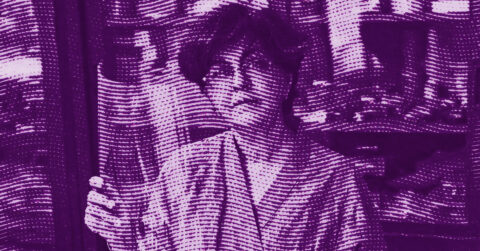Listen to me carefully, you bunch of snobs! Do you think you know contemporary landscape painting? You believe you’ve seen it all? Think again! Emma Webster is currently exhibiting at the Petzel Gallery in New York with “That Thought Might Think,” a visual explosion that shatters our certainties and redefines what it means to paint a landscape in the 21st century.
Webster is not simply a landscape painter; she is a great architect of worlds. In her Los Angeles studio, this British-American woman in her thirties does not just capture nature: she fabricates it from scratch. Armed with virtual reality technologies, she sculpts digital environments which she then translates into oil on canvas with a technical virtuosity that would make the old masters jealous. The result? Panoramic visions so destabilizing, so deliciously perverse in their relationship to reality that they make us doubt our own perception.
Take “The Material World” (2025), a monumental work more than four meters wide. Trees with twisted shapes rise like specters in a twilight of synthetic hues, while in the distance, impossibly sharp mountains seem to pierce a sky that defies the laws of physics. The light, oh, that light!, does not come from the sun but from a theatrical, artificial source, as if we were in front of a movie set rather than nature.
It is precisely this tension between the real and the artificial that makes Webster’s work resonate. She plays with our ancestral desire for nature while constantly reminding us that our perception of the natural world is irrevocably shaped by culture, technology, and imagination. As Susan Sontag wrote in “On Photography”: “Nature offers few things that organize themselves into events; we must structure it so that it becomes a spectacle” [1]. Webster takes this idea head-on, turning nature into a spectacle aware of its own theatricality.
But wait, don’t think her work is just pretty digital effects transferred into painting. That would overlook the philosophical depth that underlies her approach. In reality, Webster engages in a reflection on hyperreality that Jean Baudrillard would have savored with delight. Her landscapes are simulacra that no longer have a referent in reality; they are “the generation by models of a real without origin or reality,” to borrow the words of the French philosopher [2].
Consider “Era of Eternity” (2025), where the sky literally opens like a theater curtain to reveal a supernatural light. This work is not a representation of nature; it is a construction that reveals how much our very idea of “nature” is a cultural fabrication. In our era of climate catastrophe and ecological anxiety, Webster confronts us with the uncomfortable truth that our idyllic images of nature may be nostalgic fantasies of a world that never really existed.
And yet, her paintings attract us irresistibly. These panoramas are hypnotic, making us oscillate between intellectual mistrust and sensory surrender. Because despite all their assumed artificiality, these works touch on something deeply primordial in us, a desire for immersion in a world that goes beyond the human, that engulfs us in its grandeur.
This is where the theatrical dimension of Webster’s work takes on its full meaning. As she herself explains: “Theater is the first virtual reality” [3]. Her landscapes function like sets that invite the viewer to enter a space both physical and mental, real and simulated. It is no coincidence that Webster worked in set design before dedicating herself to painting; she viscerally understands how the stage space can become a portal to other worlds.
In her practice, technology is not an end in itself but a tool that enriches a fundamentally pictorial process. Unlike some digital artists who indulge in algorithmic perfection, Webster embraces imperfections, accidents, the traces of the human hand. Her fifty shades of green, cold, synthetic, deliberately artificial greens, create a lush visual labyrinth where the eye gets lost with delight.
And perhaps this is where the true boldness of her work lies. At a time when technology promises us ever more immersive experiences, where metaverses seduce us with their “perfect” digital environments, Webster stubbornly returns to painting, this millennia-old, tactile, sensual art, to explore our complex relationships with the natural world and its representations.
Critic Susan Sontag reminds us that “reality has always been interpreted through the images we give of it” [4]. From this perspective, Webster’s work is not simply a reflection on nature, but on our way of perceiving, representing, and desiring it. Her landscapes are mirrors that reflect back not nature itself, but our own gaze upon it.
This gaze is today irreversibly shaped by technology. We see the world through screens, apps, Instagram filters that turn even the slightest sunset into a kitsch spectacle. Webster does not reject this technological mediation; she embraces it to better question it. As Baudrillard pointed out, “it is no longer a matter of imitation, nor doubling, nor even parody. It is a substitution to the real of signs of the real” [5].
In “Griffith”, the purplish foliage framing a watercourse illuminated like a theater stage transports us to a space where nature is both present and absent. It is not an observed nature, but an imagined, dreamed, reconstructed nature from fragments of memory, desire, and anxiety. Webster creates what Baudrillard would call a “hyperreal”, more real than the real, also more seductive, because freed from the constraints of the possible.
However, unlike Baudrillard’s pessimistic vision for whom the hyperreal signifies the death of the real, Webster seems to suggest a more complex coexistence. Her landscapes do not replace nature, they enrich our dialogue with it, broaden our ability to imagine it, to desire it, perhaps even to protect it.
Speaking about her process, Webster mentions how she constructs her images: “When I work in virtual reality, I mix landscapes I have seen or parks with sketches. It’s a hybrid where I use reference elements from the real world, but many are made from ideals, things I would like to see in a landscape, or things that would surprise me in a landscape” [6]. This statement reveals an artist deeply committed not to escaping reality, but to its poetic expansion.
Because it is indeed poetry that is at stake, a visual poetry that plays with our expectations, our memories, and our projections. Webster reminds us that landscape has never been an “innocent” pictorial genre; from Claude Lorrain to Thomas Kinkade, it has always conveyed ideals, fantasies, ideologies. The difference is that she fully embraces this subjectivity, this construction.
What makes Webster’s work so relevant today is her ability to navigate between different worlds, between digital and analog, between real and virtual, between observation and invention. At a time when technology constantly redefines our relationship to the world, she offers us a space for contemplation where these tensions can coexist productively.
Sontag reminded us that “the very apprehension of what is real has been transformed by the habit of photographic representation” [7]. Today, one could say our apprehension of reality is transformed by the omnipresence of digital simulations. Webster’s genius is to make us feel this transformation not as a loss, but as a possibility, the possibility to imagine new worlds, unprecedented perspectives, different ways of being in relation to what we call “nature”.
So yes, go see this exhibition. Let yourself be carried away by these hallucinatory visions, these impossible landscapes that seem to emerge from a fevered dream. And while you’re there, ask yourself what you are really looking for when you contemplate a landscape, is it nature itself, or the idea you have of it?
Emma Webster, she seems to have found her answer. And it is radiant.
- Sontag, Susan. On Photography. Paris: Christian Bourgois, 2008.
- Baudrillard, Jean. Simulacra and Simulation. Paris: Galilée, 1981.
- Webster, Emma. Interview with Carol Real, Art Summit, March 25, 2025.
- Sontag, Susan. On Photography. Paris: Christian Bourgois, 2008.
- Baudrillard, Jean. Simulacra and Simulation. Paris: Galilée, 1981.
- Webster, Emma. Interview with Carol Real, Art Summit, March 25, 2025.
- Sontag, Susan. On Photography. Paris: Christian Bourgois, 2008.
















